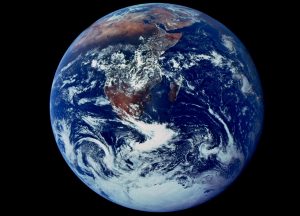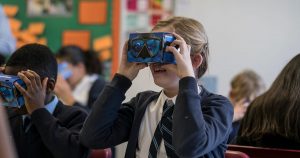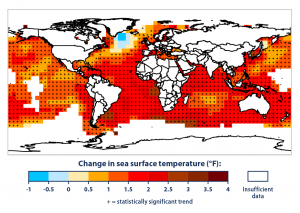Nicolas Schnoz
The world’s oceans are in a critical state that has been getting worse and worse for years, and if we do not act now, we are facing a rather bleak future. Large companies like Axa have recognized the seriousness of the situation and are committed to promoting education on this issue to help combat the problem.
Introduction
In the year 1972, NASA launched the Apollo 17 into space. On its way to the moon, one of the crew members on board of the rocket took a look out of the window and snapped within one minute four pictures of the beautiful view that was presented to him. One of those pictures, today known as The Blue Marble, later became one of the most famous pictures ever taken. It was the first-ever photograph to capture the entire globe. (Reinert, 2011) Seeing our planet from outer space, especially the southern hemisphere emphasizes just what enormous masses of water it contains and why it is known as the blue planet. To put it in numbers about 72% of the earth’s surface according to scientists is covered by water. (Encounter Edu, 2018a) However, this giant ecosystem is continuously changing and adapting, influencing vast aspects allocated all over the entire planet. Especially in the last centuries since the industrial revolution and growing human impact, the oceans have been changing faster than ever. Even though its enormous size or maybe just because of it, there still is surprisingly little known about the oceans, how they are changing, and what consequences these changes involve. (Encounter Edu, 2018b) Despite there is still a lot to explore the significant importance of the oceans for human life is undeniable. 66% of the oxygen in our atmosphere is provided by the ocean; this means every second breath of air we take comes from the ocean, it represents 95% of the planets living environment and serves as the main source of protein for over 1 billion people, just to name a few of the many services the oceans provide. These numbers show just how worthy of protection this ecosystem is. And this protection is badly needed, then since the last decades, the oceans are under constant threat. Due to overfishing about 90% of big fish, including tuna, sharks and swordfish vanished, pollution increased ocean acidification by 30% in the last 250 years, and the staggering use of plastic led to an estimated 5.25 trillion pieces of plastic in the ocean. (Encounter Edu, 2018a) As Nelson Mandela once said, „Education is the most powerful weapon which you can use to change the world.“ (Duncan, 2013) This is also the basic idea behind Axa’s engagement in ocean education. The insurance company provides with its program AXA XL Ocean Education learning resources and live education events for teachers and schools with the goal to spread awareness and create curiosity in the students about the conditions of the oceans and what has to be done to protect them in the future. (Encounter Edu, 2018a)

Figure 72.1 – Figure 1: The Blue Marble Source: Reinert, A. (2011). The Blue Marble Shot: Our First Complete Photograph of Earth. The Atlantic. Retrieved from https://www.theatlantic.com/technology/archive/2011/04/the-blue-marble-shot-our-first-complete-photograph-of-earth/237167/
AXA XL Ocean Education
The nonprofit organization Encounter Edu peruses the goal to improve the education system in and outside of the classroom. They do so by providing teachers and schools with learning resources, „virtual exchange, live expedition broadcasts, and virtual reality“. (Encounter Edu, n.d.) Alongside with their partners, they develop education programs addressing relevant and up-to-date topics which they place at the disposal of schools to implement in the classroom (Encounter Edu, 2018c). One of these partners is the previously mentioned insurance company Axa. In collaboration with Encounter Edu Axa developed AXA XL Ocean Education, a program designed to help teachers and provide them with unique teaching materials and thus also to inspire students’ interest and curiosity about the topic. Those teaching materials, designed for science and geography students between seven and 16 years of age, are divided into four subject areas, these being „Our Ocean Planet, Frozen Oceans, Coral Oceans, and Submarine STEM“. In order to create a captivating classroom experience, the learning resources consist of diversified and exciting materials such as activity sheets, photo galleries, videos, and to give the students a glimpse into the interesting world of ocean research 360VR content for a lifelike experience. To further enhance the learning experience, the live expeditions XL Catlin Arctic Live and XL Catlin Coral Live take place every year where experts go live from the Arctic and coral reefs to answer questions the students can ask directly from the classroom to the experts via video link. (Encounter Edu, 2018a) These expeditions are so popular that they result in some amazing numbers. In 300 hours of live expedition coverage, 16,000 questions from over 800 different schools were answered, and up till now, a total of 60,000 students were part of the experience. These live expeditions are not only entertaining but also effective, as the response of a student after such an event demonstrates. Louise Stone from the Recreation Road Infant School of Norwich said: „After the live session, we had a long discussion about water pollution with plastics, and we are all going to try our hardest to pick up rubbish especially if we go to the beach.“ The vast majority of teachers who used the learning materials agree that they made teaching more comfortable and improved the student’s understanding of the subject matter. According to the teachers, the provided material even helped the majority of them to enhance their teaching. In fact, the program was so successful that it received several awards and got picked up by international media all over the world. The whole AXA XL Ocean Education program shows even more impressive figures. The program was implemented in 4,360 schools across the globe in 96 different countries, the developed learning resources were downloaded over 200,000 times with an additional 1,2 million views of 360VR content, and ultimately, AXA XL Ocean Education managed to reach a staggering number of 5.88 million students. (Encounter Edu, 2018b)

Figure 72.2 – Figure 2: AXA XL Ocean Education
Source: Encounter Edu. (2018b). AXA Ocean Education. Retrieved from https://encounteredu.com/partners/axa-ocean-education/program-impact
Insurance Industry’s Interest in the Ocean Risks
The changing ocean and the risks it poses can have devastating consequences that present interesting opportunities and challenges for insurance companies. The increased risk of damage to property, health, and industries due to the changing ocean dynamics has significant implications for the insurance industry. Trustworthy risk models that can handle the complexity of this new industry are necessary to design functioning insurance policies. This can only be achieved with a deep understanding of the ocean system. New business opportunities arise for insurance companies through the transfer of marine risks to new insurance models. Insurers should recognise the risk changes associated with ocean warming and the resulting sea-level rise, changes in ecosystems and climate, and increases in the frequency and intensity of extreme events. One measure to be taken may be to re-evaluate and revise existing business strategies. Finally, the changing marine risk opens up new business opportunities for the entire insurance industry. (Niehörster & Murnane, 2018)

Figure 72.3 – Figure 3: Change in Sea Surface Temperature, 1901–2015
Source: United States Environmental Protection Agency. (2016). Climate Change Indicators: Sea Surface Temperature. Retrieved from https://www.epa.gov/climate-indicators/climate-change-indicators-sea-surface-temperature#ref6
Conclusion
Considering the current condition of our oceans, drastic measures are required in every aspect. Today’s children are the decision-makers of the future, and in the end, they are the ones that are going to have to bear the real consequences of the actions or rather inactions we have taken and will take in the future. Therefore to invest in their education on this issue is an extremely important measure of today’s decision-making generation. By providing them with a deeper understanding and generating widespread awareness about the ocean’s conditions and how to approach these issues effectively, these complex ecosystem problems are going to be addressed with the urgency and know-how that is needed. Axa, in collaboration with Encounter Edu, is taking an essential step towards a brighter, more sustainable future with competent people who acknowledge the state of urgency and are willing to take the required actions in charge. Even if one tries to keep the ocean risks as small as possible, a certain risk will always remain, which can, at the same time, lead to a new business opportunity for insurance companies. In order to have a far-reaching impact and create sustainable change, the topic of oceans must be firmly manifested in school curricula worldwide, like Encounter Edu already achieved in England (Encounter Edu, 2018a). The only chance we have to overcome the problems we face is interdisciplinary cooperation, ranging from loss prevention in the form of schooling to the anticipation of potential damage and the restoration of the ecosystem by insurance companies. There is still much to be done, but if other companies and organizations follow the example set by Axa and Encounter Edu, we will set the course for a more optimistic and promising future.
Sources
Duncan, A. (2013). Education: The Most Powerful Weapon for Changing the World: USAID Impact. Retrieved from https://blog.usaid.gov/2013/04/education-the-most-powerful-weapon/
Encounter Edu. (n.d.). Linkedin. Retrieved from https://www.linkedin.com/company/encounteredu
Encounter Edu. (2018a). AXA Ocean Education. Retrieved from https://encounteredu.com/partners/axa-ocean-education/about
Encounter Edu. (2018b). AXA Ocean Education. Retrieved from https://encounteredu.com/partners/axa-ocean-education/program-impact
Encounter Edu. (2018c). AXA Ocean Education. Retrieved from https://encounteredu.com/partners
Niehörster, F., & Murnane, R. J. (2018). Ocean Risk and the Insurance Industry. Ocean Risk and the Insurance Industry. Retrieved from http://www.oceanrisksummit.com/Content/press-releases/FALK-MAIN-REPORT-FINAL-LOW-RES.pdfhttp://www.oceanrisksummit.com/Content/press-releases/FALK-MAIN-REPORT-FINAL-LOW-RES.pdf
Reinert, A. (2011). The Blue Marble Shot: Our First Complete Photograph of Earth. The Atlantic. Retrieved from https://www.theatlantic.com/technology/archive/2011/04/the-blue-marble-shot-our-first-complete-photograph-of-earth/237167/
United States Environmental Protection Agency. (2016). Climate Change Indicators: Sea Surface Temperature. Retrieved from https://www.epa.gov/climate-indicators/climate-change-indicators-sea-surface-temperature#ref6
Media Attributions
- The-Blue-Marble-Shot
- VR-Oceans-Edu-AXA-Picture
- sea-surface-temp-figure2-2016